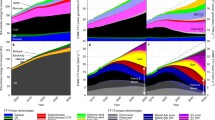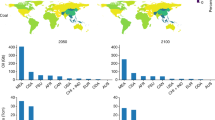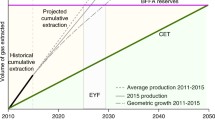Abstract
Policy-makers of some fossil fuel-endowed countries wish to know if a given fossil fuel supply project is consistent with the global carbon budget that would prevent a 2 °C temperature rise. But while some studies have identified fossil fuel reserves that are inconsistent with the 2 °C carbon budget, they have not shown the effect on fossil fuel production costs and market prices. Focusing on oil, we develop an oil pricing and climate test model to which we apply future carbon prices and oil consumption from several global energy-economy-emissions models that simulate the energy supply and demand effects of the 2 °C carbon budget. Our oil price model includes key oil market attributes, notably upper and lower market share boundaries for different oil producer categories, such as OPEC. Using the distribution of the global model results as an indicator of uncertainty about future carbon prices and oil demand, we estimate the probability that a new investment of a given oil source category would be economically viable under the 2 °C carbon budget. In our case study of Canada’s oil sands, we find a less than 5% probability that oil sands investments, and therefore new oil pipelines, would be economically viable over the next three decades under the 2 °C carbon budget. Our sensitivity analysis finds that if OPEC agreed to reduce its market share to 30% by 2045, a significant reduction from its steady 40–45% of the past 25 years, then the probability of viable oil sands expansion rises to 30%.



Similar content being viewed by others
Notes
The Paris agreement also set 1.5 °C as an aspirational limit, but we restrict our analysis here to the 2 °C limit, the target that has stimulated most analysis.
Except where a different date or currency is indicated, oil and carbon prices are in 2012 $US.
As explained by one of the report’s authors in a personal communication.
In a personal communication, one author explained that, being the result of an optimization procedure with foresight, their model’s oil price does not attempt to depict the real-world market oil price in each period.
Following industry practice, we use the more encompassing term light tight oil instead of shale oil.
Output continued to grow even after a significant decline in oil prices.
Even if some scarcity rents exist, the “green paradox” hypothesis suggests that climate policy would force producers to lower oil prices from concern that demand would fall faster than consumption would deplete supplies (Sinn 2012). Of course, if scarcity rents are negligible, as the research literature suggests, the green paradox is of little importance.
Aguilera and Radetzki (2015) attribute this underinvestment primarily to the “resource curse”—rent-seeking behavior within oil-endowed countries, and their state-owned oil corporations, that undermines the prospects for productive investments to expand capacity. Smith (2009) suggests that the underinvestment might to some extent also be a deliberate strategy. And, there have been sanctions that prevented low cost supply expansion in Iran. Regardless of the dominant underlying cause, the overall effect is the same: a higher oil price and a smaller share of global oil production for individual OPEC producers than would occur under a purely competitive global oil market.
See Figure S1 in supplemental materials.
See Figure S2 in supplemental materials.
As one reviewer noted, we could have equally designed our model as an OPEC profit maximization model, with exogenous oil demand as a constraint. The oil price outcomes would be similar.
Detailed data used to construct the cost estimates are in the supplemental material accompanying this article.
See McCollum et al. (2014) for details on the global EEE models used in EMF 27, whose key algorithms range along a continuum from optimization to simulation, and which vary in their regional and technological resolution.
We needed this calibration because the start year for EMF 27 simulations is 2010.
Assumed to approximately reflect the West Texas Intermediate benchmark oil price.
Detailed results and an expanded graph of marginal producers, Figure S3, are in the supplemental materials.
References
Aguilera RF (2014) Production costs of global conventional and unconventional petroleum. Energy Policy 64:134–140
Aguilera R, Radetzki M (2015) The price of oil, Cambridge University Press, Cambridge, UK
British Petroleum (2016) British Petroleum BP Statistical Review of World Energy. https://www.bp.com/content/dam/bp/en/corporate/pdf/energy-economics/statistical-review-2017/bp-statistical-review-of-worldenergy-2017-full-report.pdf
Canada-U.S. (2016) Canada-U.S. joint statement on climate, energy and Arctic leadership. Northern and indigenous affairs Canada. https://pm.gc.ca/eng/news/2016/03/10/us-canada-joint-statement-climate-energy-and-arctic-leadership
Canadian Association of Petroleum Producers (CAPP) (2015) Statistical Handbook. https://www.capp.ca/publications-and-statistics/statistics/statistical-handbook
Canadian Energy Research Institute (CERI) (2014) Study no. 141: Canadian oil sands supply costs and development projects (2014–2048). https://www.ceri.ca/assets/files/Study_141_Full_Report.pdf
Chan G et al (2012) The Canadian oil sands industry under carbon constraints. Energy Policy 50:540–550
Environment and Climate Change Canada (2016) Methodology for estimating the upstream greenhouse gas emissions associated with major oil and gas projects undergoing federal review. Canada Gazette, Part I. http://www.gazette.gc.ca/rp-pr/p1/2016/2016-03-19/html/notice-avis-eng.html
Erickson P, Lazarus M (2014) Impact of the keystone XL pipeline on global oil markets and greenhouse gas emissions. Nat Clim Chang 4(9):778–781
Faehn T et al (2017) Climate policies in a fossil fuel producing country: demand versus supply side policies. Energy J 38:77–102
International Energy Agency (2013a) Redrawing the Energy Climate Map: World Energy Outlook Special Report, Paris. https://www.iea.org/publications/freepublications/publication/WEO_Special_Report_2013_Redrawing_the_Energy_Climate_Map.pdf
International Energy Agency (2013b) World Energy Outlook 2013, Paris. https://www.iea.org/publications/freepublications/publication/WEO2013.pdf
International Energy Agency (2013c) Reserves to Resources 2013: Oil, gas and coal technologies for the energy markets of the future, Paris. https://www.iea.org/publications/freepublications/publication/Resources2013.pdf
International Energy Agency (2013d) Oil Medium Term Oil Market Report 2013, Paris. https://www.iea.org/publications/.../medium-term-oil-market-report-2013.html
International Energy Agency (2015) World Energy Outlook 2015, Paris. https://www.iea.org/publications/freepublications/publication/WEO2015.pdf
IPCC (2014) Intergovernmental panel on climate change, Fifth Assessment Report, Cambridge University Press, Cambridge UK
Jaccard M (2005) Sustainable fossil fuels: the unusual suspect in the quest for clean and enduring energy, Cambridge University Press, Cambridge UK
Krey V et al (2014) Getting from here to there—energy technology transformation pathways in the EMF27 scenarios. Clim Chang 123:369–382
Kriegler E et al (2015) Making or breaking climate targets: the AMPERE study on staged accession scenarios for climate policy. Technol Soc Chang 90A:24–44
Livernois J, Thille H (2015) Empirical evidence on the theory of nonrenewable resource economics, In Halvorsen and Layton (eds), Handbook on the Economics of Natural Resources, 41–65, Edward Elgar, Cheltenham UK
McCollum D et al (2014) Fossil resource and energy security dynamics in conventional and carbon-constrained worlds. Clim Chang 123:413–426
McGlade C, Ekins P (2015) The geographical distribution of fossil fuels unused when limiting global warming to 2 °C. Nature 517:187–190
Meinshausen M et al (2009) Greenhouse gas emission targets for limiting global warming to 2 °C. Nature 458:1158–1162
Obama B (2015) Statement by the president on the keystone XL pipeline, The White House: Office of the Press Secretary, Washington, D.C. https://obamawhitehouse.archives.gov/the-press-office/2015/11/06/statement-president-keystone-xl-pipeline
OPEC (2016) Organization of Petroleum Exporting Countries, Annual Statistical Bulletin, Vienna. https://www.opec.org/opec_web/static_files_project/media/downloads/publications/ASB2016.pdf
Palen W et al (2014) Consider the global impacts of oil pipelines. Nature 510:465–467
Rogelj J et al (2016) Paris agreement climate proposals need a boost to keep warming well below 2 °C. Nature 534:631–639
Sinn H-W (2012) The green paradox: a supply-side approach to global warming, The MIT Press, Cambridge US
Smith J (2009) World oil: market or mayhem? J Econ Perspect 23:145–164
U.S. Energy Information Administration (EIA), U.S. Department of Energy (2014) Venezuela Analysis Brief. https://www.eia.gov/todayinenergy/detail.php?id=9651
Van der Zwann B et al (2013) A cross-model comparison of global long-term technology diffusion under a 2° C climate change control target. Climate Change Economics, 4(4)
Victor D (2011) Global warming gridlock: creating more effective strategies for protecting the planet, Cambridge University Press, Cambridge UK
Acknowledgments
We acknowledge helpful comments from Jotham Peters, Nic Rivers, Tiffany Vass, Duncan Noble, Michael Lazarus, Harro van Asselt, and the anonymous reviewers.
Author information
Authors and Affiliations
Corresponding author
Additional information
This article is part of a Special Issue on ‘Fossil Fuel Supply and Climate Policy’ edited by Harro van Asselt and Michael Lazarus.
Rights and permissions
About this article
Cite this article
Jaccard, M., Hoffele, J. & Jaccard, T. Global carbon budgets and the viability of new fossil fuel projects. Climatic Change 150, 15–28 (2018). https://doi.org/10.1007/s10584-018-2206-2
Received:
Accepted:
Published:
Issue Date:
DOI: https://doi.org/10.1007/s10584-018-2206-2




